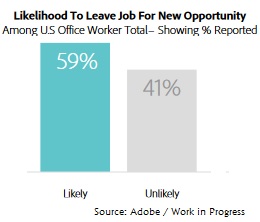The gig economy — defined by freelancers and contractors who are temporary and independent workers — is in full swing. Intuit predicts that, by 2020, 40% of American workers will be independent contractors. Today, 35% have already done work as freelancers.
Despite a recent surge in popularity, gigs are unlikely to play a significant role in reshaping the future of work. While the emergence of gigs may challenge some organizations, they aren’t a threat to most. More employers than ever expect to use or increase their use of contingent workers. The bigger threat is the serial employee — employees who spend a brief period (1-3 years) in an organization and then move on taking their knowledge, investment, and capability with them.
How should businesses prepare for this new disruption in the workforce, and what steps can they take to ensure they continue to attract and retain quality, long-term talent?
Serial employment will have a bigger impact** **
It’s hard to argue with the logic, as employees have a self-interest in extracting as much learning and growth as they can as quickly as possible. As the pace of growth decelerates, the employee moves on to the next thing.
There is nothing wrong with serial employment per se. On some level, you have to appreciate the tireless thirst for growth. That said, serial employment is expensive for companies. It’s painful to have your investment walk out the door.
What to do about the serial employee
So what to do about the serial employee? Most businesses realize that getting employees to stay beyond one round (i.e., 2-3 years) is critical to business success. And it’s not just about getting the employee to stay longer, it’s about finding new ways to unlock their potential in service of the business.
The solution is simple in concept. First, organizations must craft a compelling employee journey that offers increasing levels of challenge and growth to its employees over time.
At IDEO, we think about the experience of our designers in three distinct arcs. The first arc is about building world-class design skills. Technology is table stakes for developing those skills according to Adobe’s Work in Progress study. 81% of U.S. office workers reported that state of the art technology is the most important amenity at work, outranking food and other on-site perks.
The second is about leading others through the creative process. The third is about leveraging IDEO as a platform for one’s design vision — a vision that is personally exciting to them and aligned with the vision and direction of IDEO. Each arc builds a very different muscle for the individual and implies an increasing commitment to and from the organization.
Make it a win for both
Constructing the employee journey is one thing, making it work for each employee is a different and more difficult task. Through each arc, the goal is to weave each employee’s personal passions, desire to grow, and the needs of the business into one coherent, compelling, and mutually beneficial narrative.
What you want at the end is a win-win for both the employee and the employer — the employee grows in ways that are exciting to them and the business benefits in the immediate term. This requires people managers to have the maturity, confidence, and courage to ask employees about their life goals (not just their goals inside the organization) and to do so in a way that feels safe, non-judgmental, supportive. If managers are able to achieve this level of open and honest dialogue, organizations can begin crafting bespoke journeys for their highest performers. It may turn out that it isn’t possible to create a win-win. But if that’s the case, it’s better to know sooner vs. later so an organization can plan accordingly.
Weaving a mutually beneficial business and personal narrative requires strong line managers. When strong managers don’t exist or are still growing, the support of talent and HR professionals to role-model this skill will be critical. And from a commitment perspective, the time, energy, and emotional commitment required is significant. But when your primary asset is your talent, this is the best investment you can make.
Gigs will continue to be an interesting element of the future economy, but will never replace traditional career paths. Serial employment will be the more significant challenge for employers. Enlightened businesses that are committed to creating a compelling and personalized career path — with new levels of challenge and growth at each phase — will thrive.
—
This blog was originally posted on TLNT.com. You can find the original piece here.

